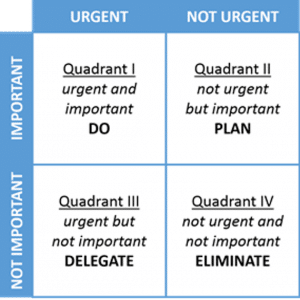I hope you are well, and welcome to Autumn. I love this time of year as the nights get chilly, the AC is off, and fresh air is blowing through the house. Hope you love it as much as me!!
In the last two weeks, I have been reminded repeatedly about Stephen Covey’s Seven Habits of Highly Effective People. Between chats with my oldest daughter about Habit #1 (Be Proactive), and business meetings where we utilized techniques from Habit #3 (Put First Things First) and Habit #2 (Begin with the End in Mind), Stephen Covey is really living in my brain!
Coincidentally, I’ve caught myself juggling a lot of different personal and business tasks, feeling overwhelmed, and getting a bit lost on the best way to prioritize and organize things. With all of the Covey reminders going on in my life, I realized that my sense of crisis is exactly what Habit #3 – Put First Things First — is designed to help. This Habit is all about building effective time management, prioritizing what is most important for me, and creating some breathing room in my week to get out of the rat race.
When introducing this habit, Covey asks two questions. I encourage you to take a moment to write down your answers:
- What one thing could you do (that you aren’t currently doing) that if you did on a regular basis, would make a tremendous positive difference in your personal life?
- What one thing could you do (that you aren’t currently doing) that if you did on a regular basis, would make a tremendous positive difference in your professional or business life?
OK, did you actually think about it for a moment and write it down? If not, get out that pen!!
The thing I really love about Habit #3 – Put First Things First, is that it introduces us to a concept of organizing our tasks into the Urgent and Important Time Management Matrix.
As you can see below, each of your tasks gets organized into one of four quadrants:
- Quadrant I – Urgent and important – DO
- Quadrant II – Not urgent, but important – PLAN (or as we refer to it PROACTIVE)
- Quadrant III – Urgent, but not important – DELEGATE
- Quadrant IV – Not urgent and not important – ELIMINATE

It’s easy to recognize ourselves in Quadrant I – there are too many critical things to do and we don’t have enough time to get them all done. It’s chaotic and helter skelter. As long as we spend all of our time in Quadrant I, it keeps getting bigger and bigger until it seems impossible to get out. When you get beat up like this, the only relief you have is to escape to Quadrant IV. This is called managing your life by crisis.
There are a fair number of people who live in Quadrant III, but think they are in Quadrant I. These people are short-term focused, see goals and plans as worthless (because they can’t ever meet them), and often feel victimized and out of control. And, frankly, Quadrant IV is a complete waste of your time. As Covey says “People who spend time almost exclusively in Quadrants III and IV basically lead irresponsible lives.” Whew. That might feel like a harsh statement, but if it does, I would encourage you to spend some personal time exploring it. How much of your day or week are spent in these Not Important quadrants?
Finally, we take a look at Quadrant II – Not urgent, but Important. This is the heart of effective personal management and this is where being proactive comes in. This is where you spend time learning new skills, building relationships, planning, exercising, implementing lessons learned exercises and root cause analysis. This is where you assess yourself and your team to find ways to improve and have a higher quality of life. Check this out if you want to know more about assessments.
As part of my personal mission, I choose to give back to others and especially enjoy coaching and mentoring young people. As it turns out, this is from Quadrant II – building relationships. A few minutes ago, I interrupted myself writing this blog so I could meet with a young man. As it turned out, he is the epitome of living in Covey’s Quadrant II. He is a customer support and data entry specialist who had a vision of being something more than his current position could offer. He wanted to move into software and become a software tester. He bought the ISTQB software tester certification book, which is a very dry and difficult book to read (even for an experienced tester). He read the book and taught it to himself every day for six months until he understood it, then he sat for the certification exam and passed it with flying colors. He figured out how to set aside some time from his daily Quadrant I – urgent and important activities, and had the drive and ambition to make his life better. I was extremely impressed!!
Will you take the challenge like this young man? Let’s go back to those initial two questions. What one thing could you do in your personal and/or professional life that, if you did on a regular basis, would make a tremendous positive difference in your life?
Remember – Put First Things First. Was this helpful for you? I would love to hear what you chose to do differently to better yourself and be more proactive.
Keep having fun,
Jeff






